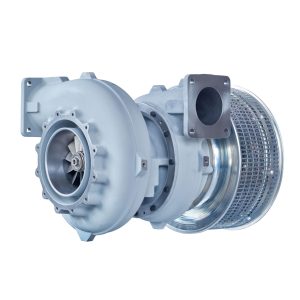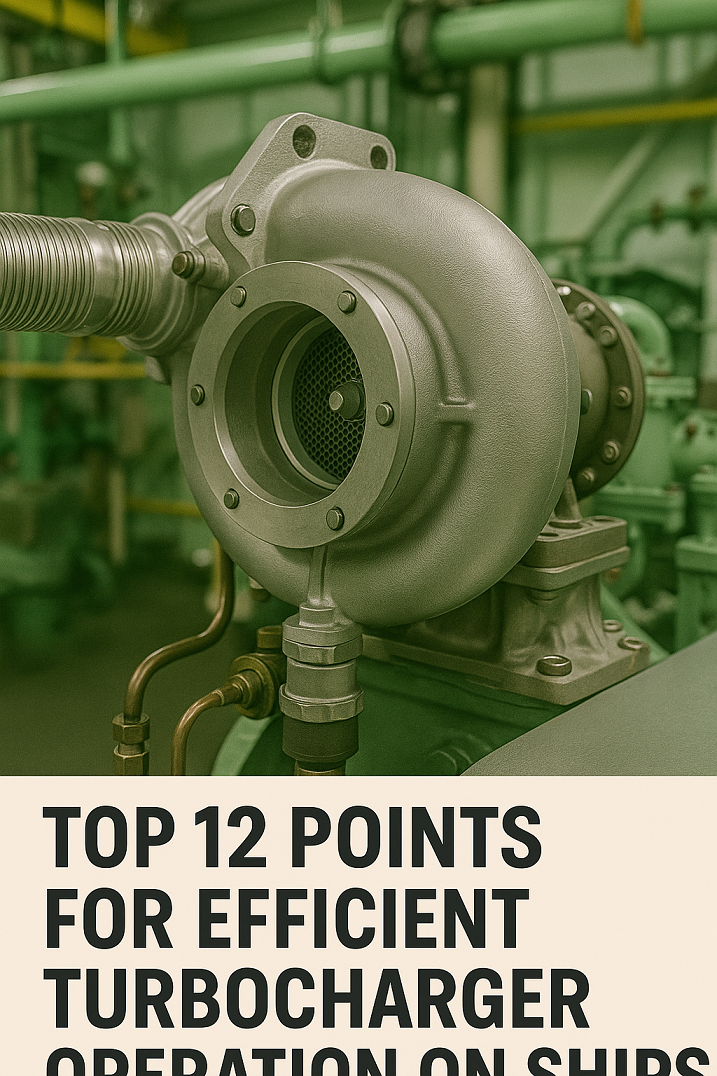Discover the top 12 essential tips for efficient turbocharger operation on ships. This expert guide covers technical insights, real-world examples, and regulatory relevance to help boost maritime engine performance and longevity.
Turbochargers are the unsung heroes of maritime propulsion systems. By compressing air into the engine’s combustion chamber, they improve engine efficiency, reduce fuel consumption, and minimize emissions. But like any precision system operating in harsh marine environments, they require careful handling. This article explores the top 12 points for ensuring efficient turbocharger operation on ships—critical knowledge for engineers, operators, and maritime students alike.

Why Efficient Turbocharger Operation Matters in Modern Maritime Operations
With rising fuel costs, stricter IMO emissions regulations, and the global push for greener shipping, marine turbochargers have never been more vital. Efficient operation reduces operating expenses (OPEX), meets regulatory targets like IMO’s MARPOL Annex VI, and ensures vessel reliability during long voyages.
According to the International Council on Combustion Engines (CIMAC), turbochargers can improve specific fuel oil consumption (SFOC) by up to 15% on two-stroke diesel engines. In an era where Environmental, Social, and Governance (ESG) compliance shapes fleet strategies, a well-maintained turbocharger isn’t a luxury—it’s a necessity.
1. Understand the Turbocharger’s Role and Construction
A turbocharger uses the engine’s exhaust gases to spin a turbine, which drives a compressor that forces more air into the engine. This process increases the oxygen available for combustion, enhancing engine power and efficiency.
It typically consists of:
- Turbine side (hot side): driven by exhaust gases.
- Compressor side (cold side): supplies pressurized air to the cylinders.
- Bearings and shaft: connect the two ends and ensure smooth rotation.
Understanding these components helps operators detect potential faults early—whether it’s fouling, imbalance, or oil leakage.
2. Follow Manufacturer Guidelines (MAN Energy Solutions, Wärtsilä, ABB)
Each turbocharger model comes with its unique maintenance and performance parameters. OEMs like MAN, Wärtsilä, ABB, and Mitsubishi provide manuals that outline:
- Recommended overhaul intervals
- Permissible operating speeds and pressures
- Acceptable vibration levels
Always consult these manuals before disassembly or adjustment. Unauthorized modifications can void warranties and violate classification society rules (e.g., DNV, ABS).
3. Ensure Clean Air Intake and Exhaust Gas Flow
Restricted airflow—either on the intake or exhaust side—can choke a turbocharger, reducing its effectiveness.
Common causes of flow restriction include:
- Dirty air filters
- Leaking or cracked piping
- Soot build-up on turbine blades
- Corroded silencers or exhaust manifolds
Using high-quality filters and conducting regular ultrasonic thickness measurements on exhaust components (as recommended by IACS) helps mitigate these issues.
4. Monitor Turbocharger Speed and Vibration
Turbochargers can spin at speeds up to 20,000–30,000 RPM on marine engines. Any imbalance can lead to catastrophic damage.
Use condition monitoring tools like:
- Shaft speed sensors
- Vibration trend analysis software (e.g., from Kongsberg Maritime or SKF)
- Thermographic imaging for bearing temperature
According to Wärtsilä’s technical bulletins, increased vibration amplitude is a leading indicator of impending bearing or blade failure.
5. Ensure Proper Lubrication and Oil Cleanliness
Bearings are the heart of any turbocharger. Inadequate lubrication causes overheating, scoring, and ultimately seizing.
Maintain:
- Clean oil free from contaminants and carbon residue
- Correct oil viscosity (check OEM spec sheet)
- Lubrication flow and pressure monitoring
Alfa Laval and MAN have stressed in their technical papers that 70% of turbocharger bearing failures trace back to poor oil quality or starvation.
6. Regular Inspection and Cleaning of Turbine and Compressor Blades
Fouling from heavy fuel oil combustion can clog turbine blades, lowering efficiency. On the compressor side, salt and oil mist from air can create sticky deposits.
Recommended actions:
- Water washing for the compressor side (while in operation)
- Dry cleaning or manual washing during scheduled maintenance
Use a borescope (as recommended by the UK’s Maritime and Coastguard Agency) to inspect hard-to-reach zones without full disassembly.
7. Monitor Scavenge Air Pressure and Temperature
If scavenge air pressure drops or temperature rises, this often signals trouble in the turbocharger or air cooler. It might indicate:
- Dirty or leaking air coolers
- Compressor fouling
- Leaks in scavenge trunking
Tracking trends through your ship’s Integrated Automation System (IAS) or Engine Data Logger helps diagnose early-stage issues.
8. Avoid Engine Overload and Sudden Load Changes
Turbochargers are not immune to stress. Rapid load changes or frequent overloading can damage components and upset the air-fuel balance.
According to ClassNK, prolonged overloading may cause blade tip erosion and thermal stress cracking on the turbine housing.
Operate the engine in accordance with the Engine Load Program (ELP) approved by classification societies and Port State Control.
9. Stay Alert to Unusual Noises and Smoke Patterns
Abnormal whistling, whining, or grinding sounds are red flags. Likewise, a sudden change in exhaust color can signal:
- Oil leakage into turbine
- Poor combustion due to underperforming turbo
- Air leakage in intake side
Use this sensory feedback as a diagnostic tool—your ears and eyes are just as important as your digital gauges.
10. Follow a Predictive Maintenance Regime
Gone are the days of just reactive or time-based maintenance. The shift is toward predictive maintenance using:
- AI-powered analytics from Inmarsat’s Fleet Data
- Engine health monitoring systems (e.g., WinGD’s WiDE platform)
- Historical performance trends
These digital tools can alert engineers before a turbocharger fault escalates into an expensive repair or engine shutdown.
11. Proper Shutdown and Cooldown Procedures
Turbochargers retain significant heat after engine stop. Abrupt shutdown can cause oil coking and thermal stress.
Cool-down procedures recommended by Wärtsilä and Mitsubishi include:
- Running engine at idle for 5–10 minutes
- Monitoring exhaust temperature drop before final stop
These simple steps prevent carbon build-up and extend bearing life.
12. Keep Detailed Records and Perform Root Cause Analyses
Every incident—from minor vibration anomalies to major failures—should be logged and followed up with a root cause analysis (RCA). Classification societies like Lloyd’s Register encourage this practice to:
- Prevent repeat failures
- Support continuous improvement
- Ensure audit-readiness during PSC or class inspections
Documentation also feeds into IMO’s Data Collection System (DCS) for GHG emissions and helps prove compliance.
Real-World Example: Turbocharger Breakdown on a VLCC
In 2023, a Very Large Crude Carrier (VLCC) in the Arabian Gulf reported heavy black smoke and engine underperformance. On inspection, engineers discovered severe turbine blade fouling and bearing scoring. Investigation showed poor-quality fuel and neglected air filter maintenance as primary causes.
The ship was delayed for 36 hours at anchorage, costing upwards of USD 120,000 in charter penalties and repairs. This case highlights why proactive care of turbochargers isn’t optional—it’s mission-critical.
FAQ: Turbocharger Operation on Ships
What is the function of a turbocharger on a ship engine?
It increases engine efficiency by using exhaust gases to compress intake air, allowing more power without increasing engine size.
How often should a marine turbocharger be overhauled?
Typically every 24,000–30,000 running hours, depending on OEM guidelines, vessel operation profile, and fuel type.
Can I clean a turbocharger while the engine is running?
Yes, water washing of the compressor side can be done during operation, provided it’s recommended by the manufacturer.
What are signs of turbocharger failure?
Reduced power, increased fuel consumption, abnormal smoke, unusual noises, or higher exhaust temperatures.
Are turbochargers required under IMO regulations?
Not directly, but they help meet emission standards under MARPOL Annex VI by improving combustion and reducing pollutants.
Can using poor-quality fuel damage turbochargers?
Absolutely. It leads to fouling, corrosion, and higher exhaust temperatures—shortening turbocharger life.
Conclusion: Turbocharger Efficiency is Engine Efficiency
Efficient turbocharger operation is the backbone of optimal marine engine performance. As global shipping faces increasing pressure to decarbonize and cut operational costs, every RPM counts. From proper lubrication to predictive analytics, each of these 12 points forms a critical piece of the efficiency puzzle.
Whether you’re a junior marine engineer or a veteran chief, treating turbochargers with the attention they deserve will ensure your vessel runs cleaner, leaner, and longer.
References
- International Maritime Organization. (2023). MARPOL Annex VI: Prevention of Air Pollution from Ships. https://www.imo.org
- Wärtsilä. (2022). Turbocharger Operation and Maintenance Manual.
- MAN Energy Solutions. (2023). Technical Service Bulletin: Turbocharger Best Practices.
- Alfa Laval. (2021). Lubrication Systems for Marine Engines. https://www.alfalaval.com
- CIMAC. (2020). Marine Engine Performance Guidelines. https://www.cimac.com
- UK Maritime and Coastguard Agency (MCA). (2022). Inspection Guidelines for Ship Engines.
- ClassNK. (2023). Marine Machinery Damage Statistics.
- Inmarsat. (2023). Fleet Data Brochure: Smart Ship Solutions. https://www.inmarsat.com
- The Nautical Institute. (2021). Marine Engineering Handbook. https://www.nautinst.org
- DNV. (2022). Class Rules for Turbochargers. https://www.dnv.com

